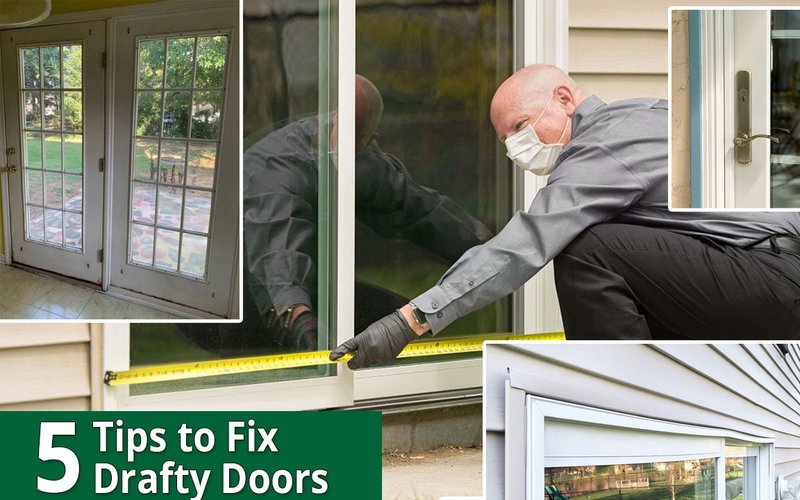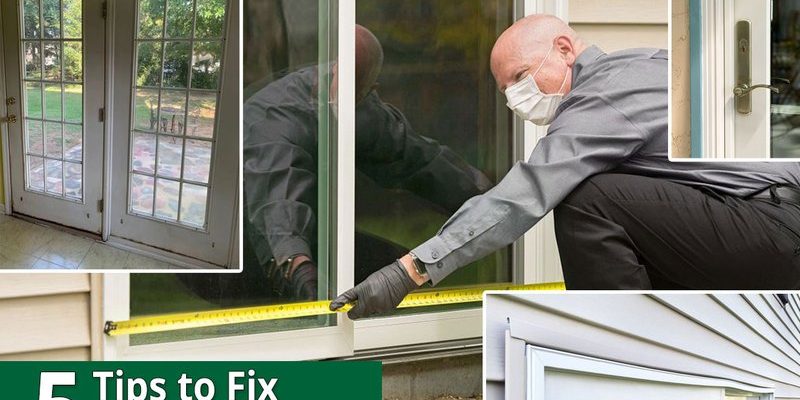
Trying to track down a door draft might seem simple: cold air + door = problem, right? But honestly, it’s more than just an annoying breeze. Drafts can point to bigger issues with the door’s seal, frame, or even something as basic as worn-out weatherstripping. Let’s walk through the reasons behind those chilly gusts and zero in on how you can fix—even prevent—drafts from worming their way under your exterior door.
What Causes Drafts Under Exterior Doors?
Here’s the thing: an exterior door isn’t just a big slab of wood or metal separating your warm living room from the wild outdoors. It’s a system, with several parts all working together to keep the weather out. When you feel drafts coming from under your exterior door, it’s usually because one (or more) of these parts isn’t quite doing its job.
Weatherstripping is a thin, usually rubber or foam strip that lines the bottom and sides of your door. Its job is to block air leaks, but over time it can dry out, crack, or peel away. If your weatherstripping looks worn or is missing completely, cold air has a straight shot into your home.
The door sweep is another barrier against drafts, attached right along the bottom edge of the door. If it’s bent, torn, or installed poorly, gaps open up and air moves right through. Sometimes, people remove door sweeps by accident during cleaning or repairs and forget to put them back.
Let me explain the third culprit: settling or shifting of the house. As houses age, they settle on their foundations, which can twist doors so they no longer fit perfectly in their frames. That leads to bigger-than-expected gaps under the door, and suddenly you’re dealing with a stubborn draft even if your weatherstripping is brand new.
How to Spot Where the Draft Is Coming From
You might be wondering: “How do I know exactly where the cold air is sneaking in?” Honestly, drafts can be sneaky—sometimes you feel them, but it’s hard to see the source. Luckily, there are a few simple tricks that make it easy to pinpoint the problem.
- Hand Test: On a chilly day, run your hand around the bottom and sides of the closed door. If you feel cold air, you’ve found a leak.
- Flashlight Method: At night, have someone shine a flashlight from outside while you stand inside in the dark. Light beams sneaking through gaps means a poor seal.
- Paper Slip Test: Close the door on a slip of paper. If it slides out easily, the seal isn’t tight enough.
If you notice cold air only at the very bottom, but not at the sides or top, it’s almost always a worn-out door sweep or missing threshold gasket.
These quick checks will help focus your troubleshooting on the exact area that needs repair, saving you time and keeping you from fixing things that aren’t even broken.
Replacing or Upgrading Weatherstripping
Let’s talk about weatherstripping, since it’s usually the first line of defense against drafts. Over the years, it can get cracked, flattened, or even start to peel up. When that happens, it just can’t block air the way it should.
Replacing weatherstripping is surprisingly easy and doesn’t require fancy tools. Here’s how you do it:
- Pull off the old weatherstripping by hand. If it’s stuck, a putty knife can help loosen stubborn bits.
- Clean the door frame thoroughly so the new material will stick well—use soap and water or a bit of rubbing alcohol to remove dirt and grease.
- Measure the length you need and cut the new weatherstripping to fit. Peel and stick versions are the easiest for beginners.
- Press the weatherstripping firmly into place, making sure it creates a snug seal but doesn’t block the door from closing properly.
You might be tempted by the cheapest option at the hardware store, but honestly, investing a couple extra bucks in high-quality weatherstripping pays off in durability and better sealing. If you have a fancier door, like one from Pella or Therma-Tru, check for brand-specific weatherstripping to ensure a perfect fit.
Fixing or Installing a Door Sweep
If your draft is coming from directly underneath the door, it’s likely time to look at the door sweep. Think of a door sweep like a little flexible brush or strip that’s attached to the bottom of your door and scrapes lightly against the threshold as you open and close it.
Installation is straightforward, but some people avoid it because they’re nervous about using a drill or screwdriver. Don’t stress—it’s easier than you think.
- Open your exterior door and look for the existing sweep (if there is one). Remove it by unscrewing or sliding it off.
- Pick a new sweep that matches the width and thickness of your door. Universal sweeps work for most doors, but if you have a branded door or unique model, check if there’s a manufacturer-recommended part.
- Hold the sweep against the bottom of the door and mark the screw holes with a pencil. Drill small pilot holes if needed, then screw the sweep onto the door.
- Close the door and double-check that the sweep brushes lightly against the threshold—too tight, and the door might be hard to close; too loose, and it won’t block drafts.
A new door sweep can stop a draft dead in its tracks. If you’re still feeling cold air after a replacement, you might need to look at the threshold or the door itself.
Adjusting or Replacing the Door Threshold
Here’s where it gets a bit more serious: sometimes the trouble isn’t with the door or the sweep, but with the threshold—the raised strip you step over when you enter or exit. If it’s damaged, worn down, or out of alignment, air can slip right underneath.
Some thresholds come with adjustable screws. These let you raise or lower the threshold to create a tighter seal against the bottom of the door. Just turn each screw a little at a time and check your results. If your threshold is cracked, warped, or missing a gasket, though, you’ll probably need to replace it.
Replacing a threshold can be DIY, but it does require removing the old piece (sometimes using a pry bar), cleaning the area, and screwing in a new one. Be ready for some light code and handy work. If you have a complicated door frame or aren’t comfortable with tools, it might be worth calling a pro.
Pro tip: Always check the manufacturer’s recommendations before replacing a threshold—especially on custom doors or branded exterior models. The wrong threshold can cause water leaks or even void your warranty.
When You Need to Adjust or Replace the Entire Door
Sometimes, no matter how much you tweak the weatherstripping, sweep, or threshold, you still can’t shake that nagging draft. Here’s the tough truth: your door might be warped or the frame could be out of square due to settling or water damage.
Doors can bend over time because of heavy use, moisture, or plain old age. If you see light around the edges, or if the door struggles to latch correctly, a warped door is likely. In these cases, minor fixes just won’t cut it anymore.
You have a couple of options. You can try to adjust the hinges—sometimes tightening them or shimming them slightly can improve the fit and help the door sit squarely in the frame. But if the draft is severe or the door is visibly twisted, it may be time to invest in a new exterior door. Modern doors, whether steel, fiberglass, or wood, are often better insulated and designed to prevent drafts altogether.
Temporary Fixes for Drafts When You Can’t Repair Right Away
We all get busy, and sometimes you need a quick solution before you have time to tackle a bigger repair. Maybe there’s a cold snap and you’re not ready to buy new parts. Here are a few fast fixes:
- Draft stoppers or “door snakes”: These fabric tubes simply rest on the floor and block air from slipping under the door. They’re cheap, easy, and can be DIY-ed with a towel if you’re in a pinch.
- Foam tape or temporary weatherstripping: Pick up a roll at the hardware store and stick it along problem areas for a seal until you do a proper repair.
- Rugs or mats: Laying a thick rug right up to the door can help cut down on the breeze, though it won’t stop the draft completely.
These quick fixes don’t solve the real problem, but they’ll help you stay warm until you can get to the root of the issue. If you find yourself reaching for the draft stopper every year, though, it’s time to plan a more permanent fix.
Why Fixing Door Drafts Actually Matters
You might be tempted to ignore a little draft, especially if you’ve gotten used to reaching for a sweater. But here’s the thing: those sneaky breezes can cost you a lot more than a bit of comfort.
A drafty door makes your heating and cooling system work overtime. That means higher energy bills—sometimes hundreds of dollars extra a year—especially if you have to keep cranking up the thermostat just to stay comfortable. It can also let in dust, pollen, and even bugs from outside, making your home less healthy.
Fixing drafts is also about protecting your house. Moisture that sneaks in during a rainstorm can sit beneath the door, eventually leading to rot, mold, or warped flooring. So even if the draft feels small now, solving it quickly is a smart move.
Final Thoughts on Troubleshooting Door Drafts
Chasing down a draft under your exterior door can feel a bit like a home repair version of hide and seek. With a little patience and the right tools—plus a good eye for worn weatherstripping or a sagging threshold—you can stop those chilly gusts for good. Whether you go for a quick fix like a draft snake or take on a full replacement, just remember: a tight seal means comfort, lower bills, and a house that feels solid and cared for all year long.
